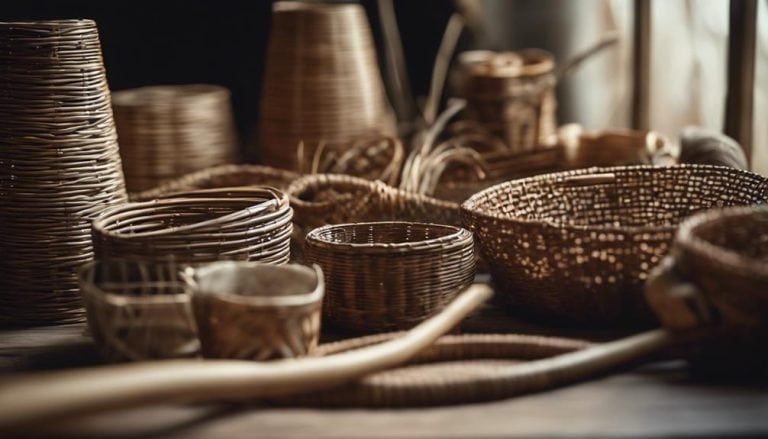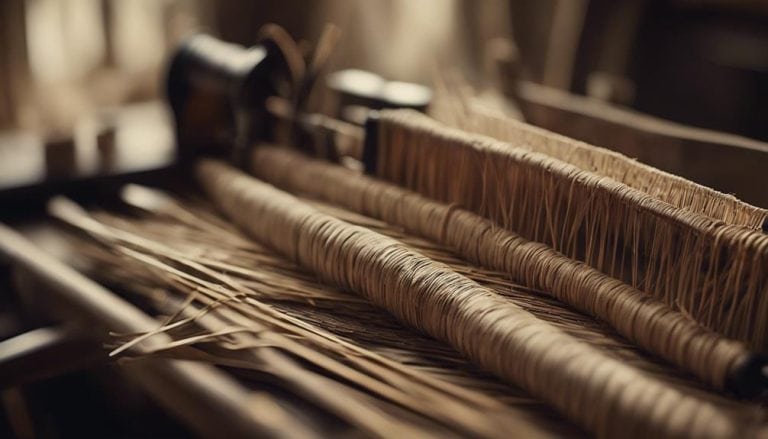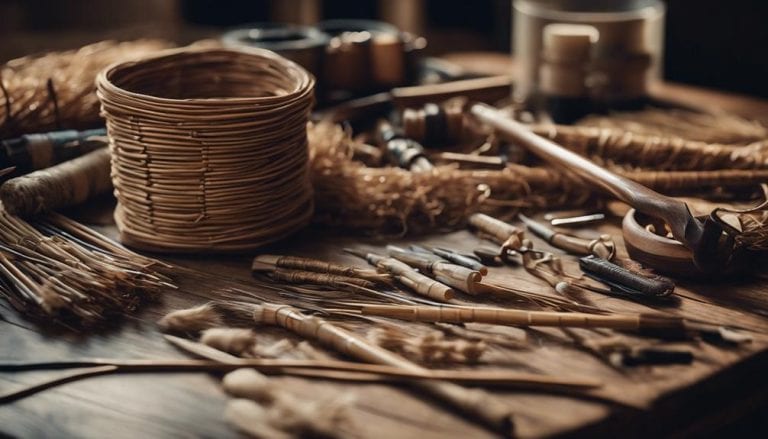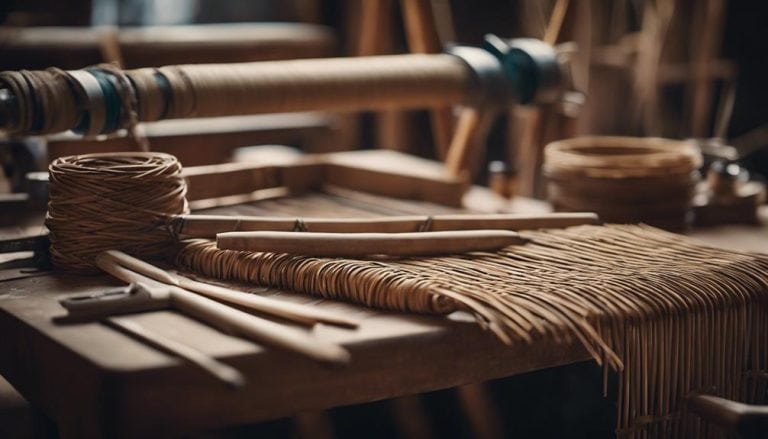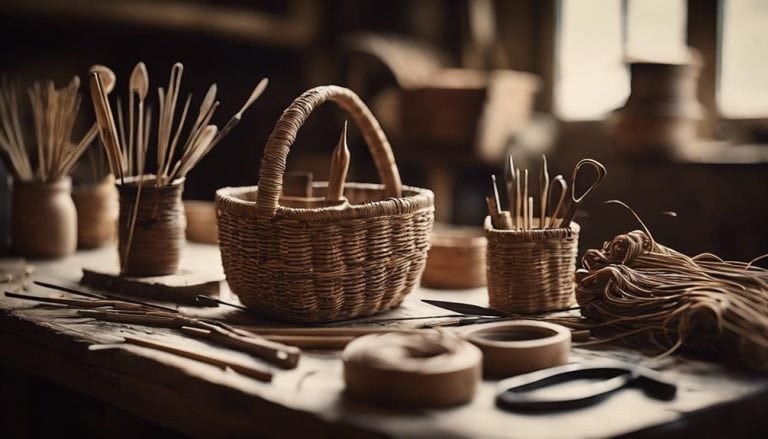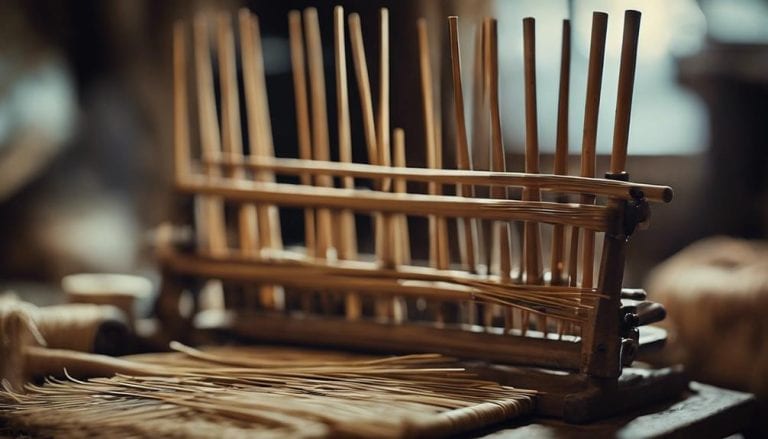Rattan Weaving Tools for Beginners
As the saying goes, “A craftsman is only as good as his tools.” Regarding rattan weaving, having the right tools can make all the difference in your projects. Each tool, from reed cutters to spoke weights, is crucial in creating beautiful, sturdy weaves. But what are the must-have tools for beginners? Let’s explore the essential rattan weaving tools that can set you on the path to mastering this ancient craft with precision and finesse.
Discover essential rattan weaving tools for beginners to craft beautiful creations easily and efficiently. These tools include a weaving needle, scissors, measuring tape, and comb.
Key Takeaways
- Essential tools like sharp scissors and needles are crucial for beginners in rattan weaving.
- Choosing the right weaving needles impacts the project outcome, from straight lines to intricate designs.
- Proper selection and use of cutting tools, like reed cutters and spoke weights, aid in weaving success.
- Safety, technique, maintenance, and storage guidelines are vital for beginners to master rattan weaving tools.
Essential Rattan Weaving Tools
When starting your rattan weaving journey, having the essential tools is crucial for a smooth and successful weaving experience. Basic techniques in rattan weaving require tools like sharp basket scissors, angle or side cutters, an awl, and a spoke weight. These tools are fundamental for cutting and shaping rattan reeds, creating intricate patterns, and ensuring a sturdy final product.
For beginners, a basic rattan weaving tool set may include needle nose pliers, a knife, measuring tape, clothespins, and a towel with a water bucket for soaking materials. These beginner resources are essential for measuring, cutting, and securing rattan during weaving.
Additionally, suppliers such as Arnies Arts and Crafts, East Troy Basketry, and others offer a variety of rattan weaving tools suitable for novices. Acquiring the necessary tools and familiarizing oneself with their uses are vital steps in mastering the art of rattan weaving.
Types of Weaving Needles
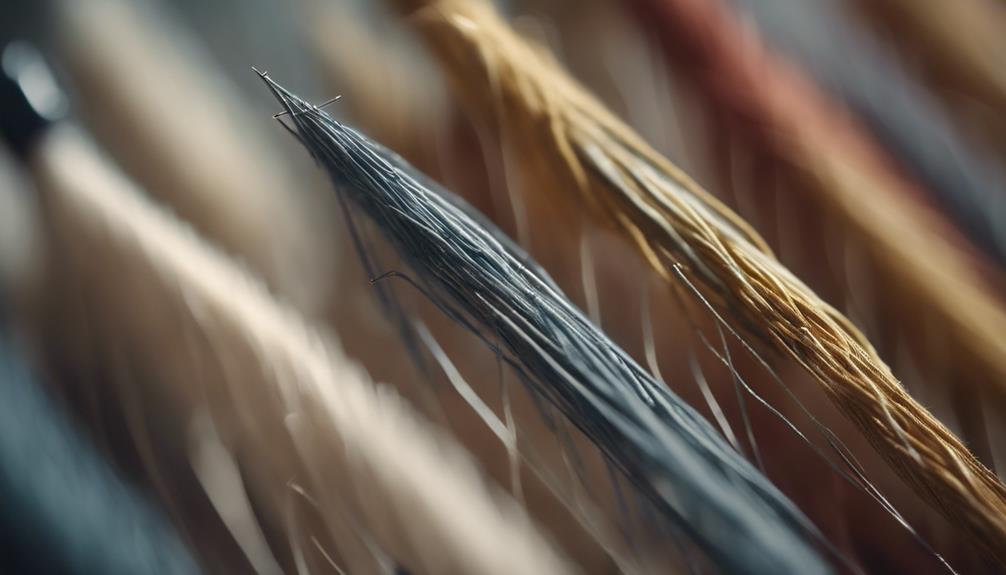
Exploring the world of rattan weaving tools further, the discussion now turns to the various weaving needles commonly utilized in this craft. When it comes to rattan weaving, selecting the right type of needle is crucial for the success of your project.
Here are the three main types of weaving needles used in rattan weaving:
| Type of Needle | Description | Best Use |
|---|---|---|
| Flat Needles | Perfect for tight stitches and straight lines, ideal for weaving techniques requiring precision. | Weaving techniques that involve straight lines and edges. |
| Round Needles | It is helpful for intricate designs and reaching tight spaces, essential for advanced weaving techniques. | Beginner projects that involve circular designs and shapes. |
| Curved Needles | Helpful for intricate designs and reaching tight spaces, essential for advanced weaving techniques. | Advanced weaving techniques that require detailed designs. |
Selecting the appropriate needle for your rattan weaving project is essential as it can significantly impact the outcome of your creation. Whether you are a beginner working on simple projects or an experienced weaver tackling complex designs, having the right needle at your disposal is key to success.
Choosing the Right Reed Cutter
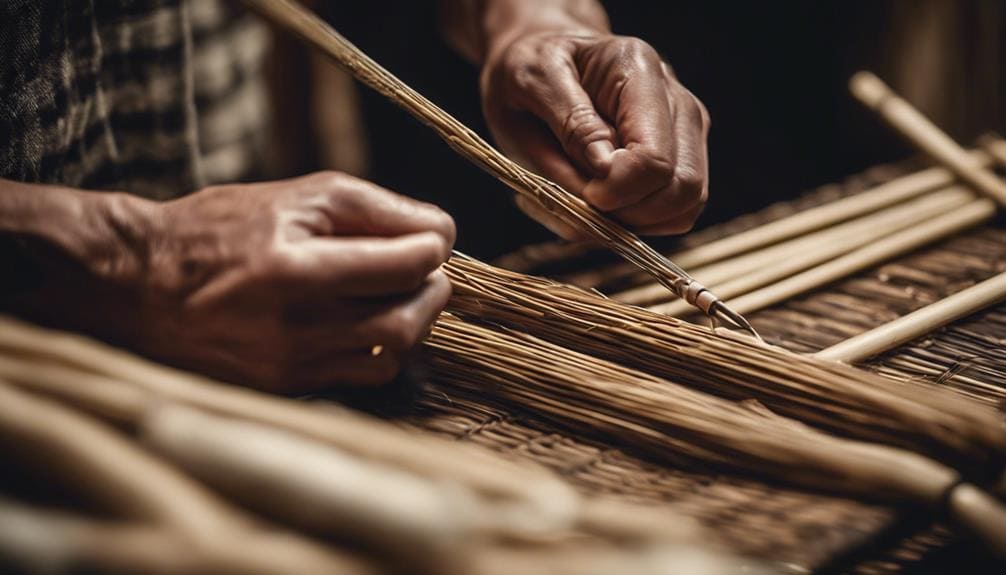
In my experience, selecting the right reed cutter is crucial for achieving precise and efficient cuts in basket weaving projects. When choosing a reed cutter, consider its maintenance requirements and sharpening techniques. Ensuring the blade stays sharp will help you cut through the reed smoothly and accurately. Look for reed cutters with ergonomic designs and various grip options.
A comfortable grip will prevent hand fatigue during long weaving sessions and allow for better control over the cutting process. Opt for a reed cutter with a thin and flexible steel tip to navigate tight gaps in weaving and a passivation treatment to prevent scratching the material.
Pick a durable cutter that provides leverage for the smooth and precise cutting of reed strands. By paying attention to these features, you can enhance your basket weaving experience and achieve professional results.
Importance of Pencil in Weaving
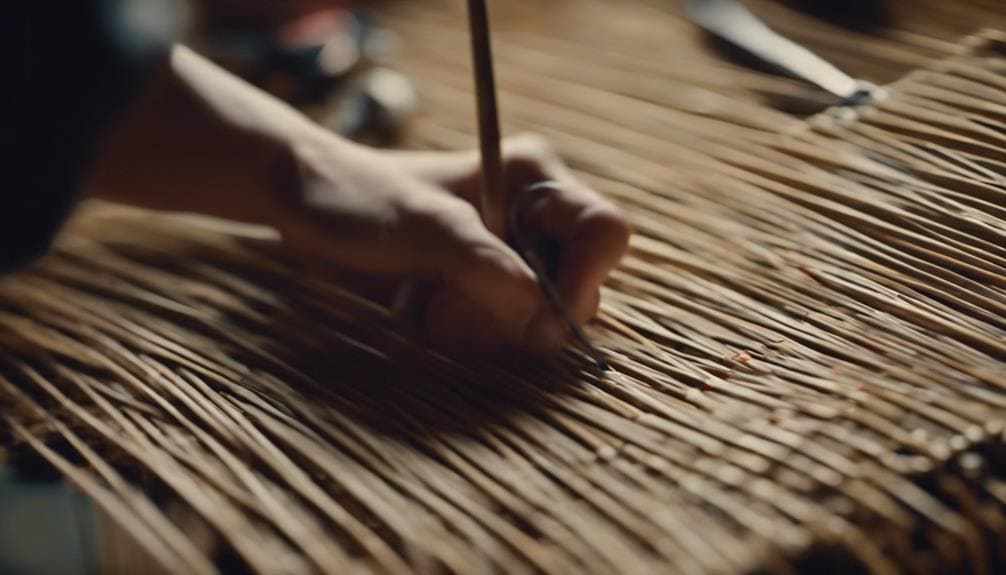
Having the right tools for weaving, such as a pencil, plays a crucial role in accurately marking measurements and patterns on the reed. When exploring weaving techniques and color palettes, a pencil becomes a weaver’s best friend for jotting ideas and sketching creative designs.
As I delve into pattern planning, the pencil allows me to draft intricate designs directly onto the weaving material, ensuring a clear roadmap for my project. The erasable nature of pencil markings allows me to make corrections and adjustments on the fly, fostering a seamless weaving process.
Moreover, pencils are versatile tools that adapt effortlessly to weaving materials like rattan, cane, and reed, making them a must-have accessory for any weaver striving for precision and creativity.
| Benefits of Pencils in Weaving | Description | Example |
|---|---|---|
| Accurate Measurements | Ensures precise marking for intricate patterns | Creating symmetrical designs |
| Easy Corrections | Allows for quick adjustments during the weaving process | Modifying pattern details |
| Versatile Tool | Can be used on various weaving materials | Sketching on both rattan and cane |
Using Spoke Weight for Weaving
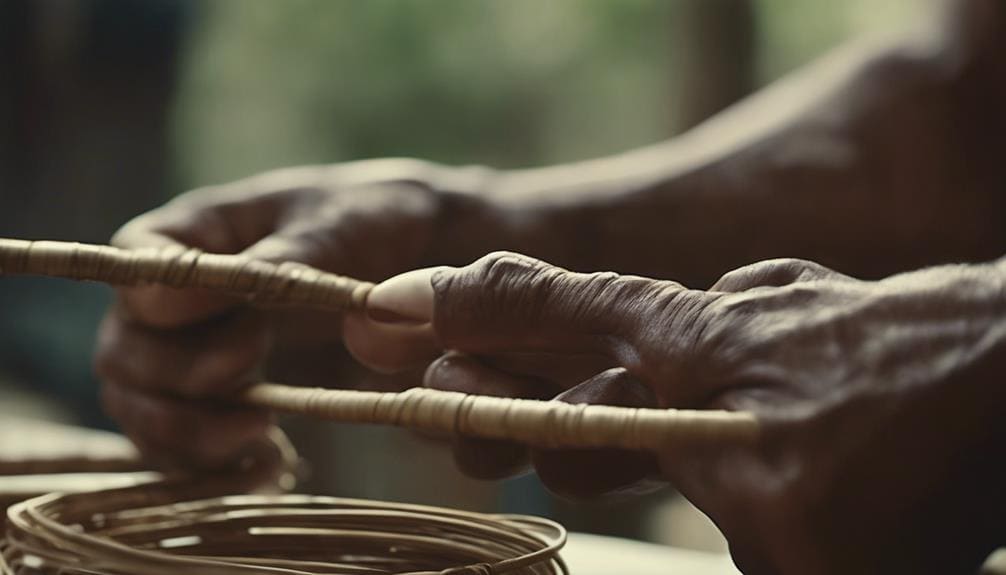
Utilizing a spoke weight in basket weaving enhances the stability of stakes and ensures consistent tension throughout the weaving process.
Here’s how spoke weights can significantly improve your weaving experience:
- Tension Control: Using a spoke weight can better control the tension in your weaving. This results in a more uniform and professional-looking final product, as the stakes remain securely in place, preventing any slack that could lead to an uneven weave.
- Stabilization Technique: The spoke weight acts as a stabilizing anchor, keeping the stakes firmly grounded. This technique helps maintain the basket’s shape and streamlines the weaving process by preventing unnecessary movements or adjustments of the stakes.
- Weaving Efficiency: With the added stability from the spoke weight, you can weave more efficiently. The stakes’ constant tension and secure positioning allow you to focus on the weaving pattern, leading to greater precision and faster progress in your projects.
Benefits of Straight-Tipped Packer

Enhancing the stability and tightening the weave, a straight-tipped packer is a vital tool in basket weaving for consolidating layers of material and securing weaving elements effectively. This tool plays a crucial role in achieving professional results when it comes to advanced weaving techniques. By using the straight-tipped packer, I can ensure that each element of my design is firmly in place, contributing to the overall strength and durability of the basket.
The straight-tipped packer becomes even more indispensable as I delve into more intricate basket-weaving projects and design ideas. Its ability to press down on the weaving elements with precision allows me to create intricate patterns and shapes easily. Whether working on a traditional basket design or experimenting with modern weaving concepts, this tool consistently proves its worth in my weaving arsenal.
Incorporating the straight-tipped packer into their weaving routine can elevate the quality of their work for both beginners and experienced weavers. Its simplicity in use and significant impact on the final product makes it a must-have tool for anyone serious about mastering the art of basket weaving.
Cutting Techniques With Box Cutter
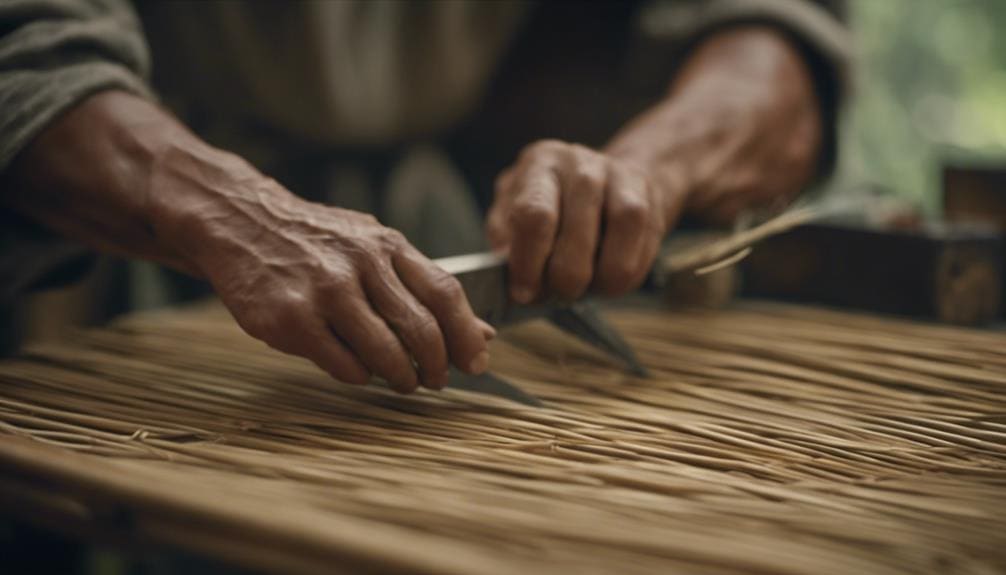
When handling intricate basket weaving projects, mastering cutting techniques with a box cutter is essential for achieving precise and clean cuts on reed materials. As you delve into using a box cutter for your rattan weaving endeavors, here are some essential tips to keep in mind:
- Safety Tips:
- Always cut away from your body to avoid accidents.
- Use a cutting mat or protective surface to prevent damage to your work surface.
- Keep your fingers clear of the blade’s path to prevent injuries.
- Blade Maintenance:
- Regularly check the blade for any signs of dullness or damage.
- Replace the blade when necessary to ensure clean cuts.
- Store the box cutter safely to prevent accidents and maintain blade sharpness.
Mastering cutting with a box cutter requires practice, caution, and attention to detail. Following these safety tips and maintaining your blade can achieve precise cuts for your rattan weaving projects.
Frequently Asked Questions
What Is the Simplest Basket Weaving Technique?
The simplest basket weaving technique involves the plain weave, weaving over one stake and under the next. Understanding this basic technique is crucial for mastering basket weaving. It sets the foundation for exploring advanced patterns with traditional methods and modern twists.
What Equipment Do You Need for Weaving?
Basic tools like reed cutters spoke weights, and packers are essential when weaving. These tools aid in the process, making it smoother and more enjoyable. Having the right equipment ensures a successful and rewarding weaving experience.
What Is Needed for Basket Weaving?
You’ll need basic materials like reeds or cane, a sturdy base, and binding materials for basket weaving. Beginner projects often start with simple designs, like a round reed basket, which teach foundational techniques.
What Are the Tools Used by Basket Weavers?
Essential tools like reed cutters spoke weights, and packers are crucial when weaving. They aid in precision and efficiency. Additional tools, such as metal and plastic clamps, support intricate designs.
Conclusion
As I wrap up my weaving journey with these essential rattan tools, I can’t help but feel like a modern-day artisan, crafting intricate designs with each stitch. Just like a painter with a brush or a sculptor with a chisel, these tools have become an extension of my creativity. So, whether you’re a beginner or a seasoned weaver, remember that with the right tools in hand, the possibilities are endless. Embrace the art of weaving and let your imagination run wild.


